A Compact and Efficient Boost Converter in a 28 nm CMOS with 90 mV Self-Startup and Maximum Output Voltage Tracking ZCS for Thermoelectric Energy Harvesting
Abstract
1. Introduction
2. System Design
2.1. Proposed System
2.2. Self-Startup Circuit
2.3. Loss Analysis for Startup
2.4. Loss Analysis for Boost Converter
3. Implementation
3.1. Adaptive MPPT Controller
3.2. Indirect ZCS Controller
4. Measured Results
5. Conclusions
Author Contributions
Funding
Acknowledgments
Conflicts of Interest
Appendix A

Appendix B
| Symbol | Definition |
| A-MPPT | Adaptive maximum power point tracking |
| DCM | Discontinuous conduction mode |
| FOCV | Fractional open circuit voltage |
| I-ZCS | Indirect zero current switching |
| MOVT | Maximum output voltage tracking |
| MPPT | Maximum power point tracking |
| PDC | Programmable delay controller |
| ZCS | Zero current switching |
| VD | Voltage detector |
| LVT | Low threshold voltage |
| HVT | High threshold voltage |
| SVT | Standard threshold voltage |
| SLVT | Super-low threshold voltage |
| SC | Switched capacitor |
| IIND | Inductor current |
| VTH | Threshold voltage |
| AV1 | Voltage gain of a single inverter |
| AV2 | Voltage gain of the gain-boosted buffer |
| PR,startup | Resistive power loss of startup circuit |
| PSW,startup | Switching loss of startup circuit |
| PQ,startup | Power consumption of startup circuit |
| PR,boost | Resistive power loss of boost converter |
| PSW,boost | Switching loss of boost converter |
| PQ,boost | Power consumption of boost converter |
| VOUT,AVG(n) | Current average output voltage |
| VOUT,AVG(n − 1) | Previous average output voltage |
References
- Condon, F.; Martínez, J.M.; Eltamaly, A.M.; Kim, Y.-C.; Ahmed, M.A. Design and implementation of a cloud-IoT-based home energy management system. Sensors 2023, 23, 176. [Google Scholar] [CrossRef] [PubMed]
- Zhu, S.; Fan, Z.; Feng, B.; Shi, R.; Jiang, Z.; Peng, Y.; Gao, J.; Miao, L.; Koumoto, K. Review on wearable thermoelectric generators: From devices to applications. Energies 2022, 15, 3375. [Google Scholar] [CrossRef]
- Xiao, H.; Qi, N.; Yin, Y.; Yu, S.; Sun, X.; Xuan, G.; Liu, J.; Xiao, S.; Li, Y.; Li, Y. Investigation of self-powered IoT sensor nodes for harvesting hybrid indoor ambient light and heat energy. Sensors 2023, 23, 3796. [Google Scholar] [CrossRef] [PubMed]
- Wahbah, M.; Alhawari, M.; Mohammad, B.; Saleh, H.; Ismail, M. Characterization of human body-based thermal and vibration energy harvesting for wearable devices. IEEE J. Emerg. Sel. Top. Circuits Syst. 2014, 4, 354–363. [Google Scholar] [CrossRef]
- Kilani, D.; Mohammad, B.; Alhawari, M. Switched inductor DC–DC boost regulator using voltage-to-time controller for TEG applications. Energies 2022, 15, 3330. [Google Scholar] [CrossRef]
- Ramadass, Y.K.; Chandrakasan, A.P. A battery-less thermoelectric energy harvesting interface circuit within 35 mV startup voltage. IEEE J. Solid-State Circuits 2011, 46, 333–341. [Google Scholar] [CrossRef]
- Kim, J.; Kim, C. A DC-DC boost converter with variation-tolerant MPPT technique and efficient ZCS circuit for thermoelectric energy harvesting system. IEEE Trans. Power Electron. 2013, 28, 3827–3833. [Google Scholar] [CrossRef]
- Qiu, Y.; Liempd, C.V.; Veld, B.O.; Blanken, P.G.; Hoof, C.V. 5 μW-to-10 mW input power range inductive boost converter for indoor photovoltaic energy harvesting with integrated maximum power point tracking algorithm. In Proceedings of the 2011 IEEE International Solid-State Circuits Conference, San Francisco, CA, USA, 20–24 February 2011; pp. 118–120. [Google Scholar]
- Chandrarathna, S.C.; Lee, L.W. A dual-stage boost converter using two-dimensional adaptive input-sampling MPPT for thermoelectric energy harvesting. IEEE Trans. Circuits Syst. I Reg. Pap. 2019, 66, 4888–4900. [Google Scholar] [CrossRef]
- Fuketa, H.; O’uchi, S.; Matsukawa, T. Fully integrated, 100 mV minimum input voltage converter with gate-boosted charge pump kick-started by LC oscillator for energy harvesting. IEEE Trans. Circuits Syst. II Express Briefs 2017, 64, 392–396. [Google Scholar] [CrossRef]
- Kim, J.; Mok, P.K.T.; Kim, C.; Teh, Y.K. A low-voltage high-efficiency voltage doubler for thermoelectric energy harvesting. In Proceedings of the 2013 IEEE International Conference of Electron Devices and Solid-state Circuits, Hong Kong, China, 3–5 June 2013; pp. 1–2. [Google Scholar]
- Intaschi, L.; Bruschi, P.; Iannaccone, G.; Dalena, F. A 220 mV input, 8.6 step-up voltage conversion ratio, 10.45 μW output power, fully integrated switched-capacitor converter for energy harvesting. In Proceedings of the 2017 IEEE Custom Integrated Circuits Conference (CICC), Austin, TX, USA, 30 April–3 May 2017; pp. 1–4. [Google Scholar]
- Weng, P.S.; Tang, H.Y.; Ku, P.C.; Lu, L.H. 50 mV input batteryless boost converter for thermal energy harvesting. IEEE J. Solid-State Circuits 2013, 48, 1031–1041. [Google Scholar] [CrossRef]
- Alhawari, M.; Mohammad, B.; Saleh, H.; Ismail, M. An efficient polarity detection technique for thermoelectric harvester in L-based converter. IEEE Trans. Circuits Syst. I Reg. Pap. 2017, 64, 705–716. [Google Scholar] [CrossRef]
- Mu, J.; Liu, L. A 12 mV input, 90.8% peak efficiency CRM boost converter with a sub-threshold startup voltage for TEG energy harvesting. IEEE Trans. Circuits Syst. I Reg. Pap. 2018, 65, 2631–2640. [Google Scholar] [CrossRef]
- Das, A.; Gao, Y.; Kim, T.T.H. A 220 mV power-on-reset based self-starter with 2 nW quiescent power for thermoelectric energy harvesting systems. IEEE Trans. Circuits Syst. I Reg. Pap. 2017, 64, 217–226. [Google Scholar] [CrossRef]
- Teh, Y.K.; Mok, P.K.T. Design of transformer-based boost converter for high internal resistance energy harvesting sources with 21 mV self-startup voltage and 74% power efficiency. IEEE J. Solid-State Circuits 2014, 49, 2694–2704. [Google Scholar] [CrossRef]
- Shang, Z.; Zhao, Y.; Gou, W.; Geng, L.; Lian, Y. 83.9% efficiency 100-mV self-startup boost converter for thermoelectric energy harvester in IoT applications. IEEE Trans. Circuits Syst. II Express Briefs 2020, 67, 1654–1658. [Google Scholar] [CrossRef]
- Radin, R.L.; Sawan, M.; Galup-Montoro, C.; Schneider, M.C. A 7.5 mV-input boost converter for thermal energy harvesting with 11 mV self-startup. IEEE Trans. Circuits Syst. II Express Briefs 2020, 67, 1379–1383. [Google Scholar] [CrossRef]
- Alhawari, M.; Mohammad, B.; Saleh, H.; Ismail, M. An efficient zero current switching control for L-based DC–DC converters in TEG applications. IEEE Trans. Circuits Syst. II Express Briefs 2017, 64, 294–298. [Google Scholar] [CrossRef]
- Katic, J.; Rodriguez, S.; Rusu, A. A dual-output thermoelectric energy harvesting interface with 86.6% peak efficiency at 30 μW and total control power of 160 nW. IEEE J. Solid-State Circuits 2016, 51, 1928–1937. [Google Scholar] [CrossRef]
- Bose, S.; Johnston, M.L. A stacked-inverter ring oscillator for 50 mV fully-integrated cold-start of energy harvester. In Proceedings of the 2018 IEEE International Symposium on Circuits and Systems (ISCAS), Florence, Italy, 27–30 May 2018; pp. 1–5. [Google Scholar]
- Qian, Y.; Zhang, H.; Chen, Y.; Qin, Y.; Lu, D.; Hong, Z. A SIDIDO DC-DC converter with dual-mode and programmable-capacitor-array MPPT control for thermoelectric energy harvesting. IEEE Trans. Circuits Syst. II Express Briefs 2017, 64, 952–956. [Google Scholar] [CrossRef]
- Marlow Industries, Inc. Single-Stage Thermoelectric Gen. Available online: http://www.eleparts.co.kr/goods/view?no=4236867 (accessed on 1 August 2022).
- Luo, Z.; Zeng, L.; Lau, B.; Lian, Y.; Heng, C.H. A sub-10 mV power converter with fully integrated self-start, MPPT, and ZCS control for thermoelectric energy harvesting. IEEE Trans. Circuits Syst. I Reg. Pap. 2018, 65, 1744–1757. [Google Scholar] [CrossRef]
- Chen, P.H.; Cheng, H.C.; Lo, C.L. A single-inductor triple-source quad-mode energy harvesting interface with automatic source selection and reversely polarized energy harvesting. IEEE J. Solid-State Circuits 2019, 54, 2671–2679. [Google Scholar] [CrossRef]
- Jeong, J.; Shim, M.; Maeng, J.; Park, I.; Kim, C. A high-efficiency charger with adaptive input ripple MPPT for low-power thermoelectric energy harvesting achieving 21% efficiency improvement. IEEE Trans. Power Electron. 2020, 35, 347–358. [Google Scholar] [CrossRef]
- Yoon, K.S.; Hong, S.W.; Cho, G.H. Double pile-up resonance energy harvesting circuit for piezoelectric and thermoelectric materials. IEEE J. Solid-State Circuits 2018, 53, 1049–1060. [Google Scholar] [CrossRef]
- Cao, P.; Qian, Y.; Xue, P.; He, J.; Hong, Z. A bipolar-input thermoelectric energy-harvesting interface with boost/flyback hybrid converter and on-chip cold starter. IEEE J. Solid-State Circuits 2019, 54, 3362–3374. [Google Scholar] [CrossRef]
- Chandrarathna, S.C.; Lee, L.W. A self-resonant boost converter for photovoltaic energy harvesting with a tracking efficiency > 90% over an ultra-wide source range. IEEE J. Solid-State Circuits 2022, 57, 1865–1876. [Google Scholar] [CrossRef]
- Amin, S.S.; Mercier, P.P. MISIMO: A multi-input single-inductor multi-output energy harvesting platform in 28-nm FDSOI for powering net-zero-energy systems. IEEE J. Solid-State Circuits 2018, 53, 3407–3419. [Google Scholar] [CrossRef]
- Tang, Y.W.; Wong, C.H.; Du, Y.; Du, L.; Li, Y.; Chang, M.C.F. A fully integrated 28nm CMOS dual source adaptive thermoelectric and RF energy harvesting circuit with 110 mV startup voltage. In Proceedings of the 2018 IEEE Custom Integrated Circuits Conference (CICC), San Diego, CA, USA, 8–11 April 2018; pp. 1–4. [Google Scholar]


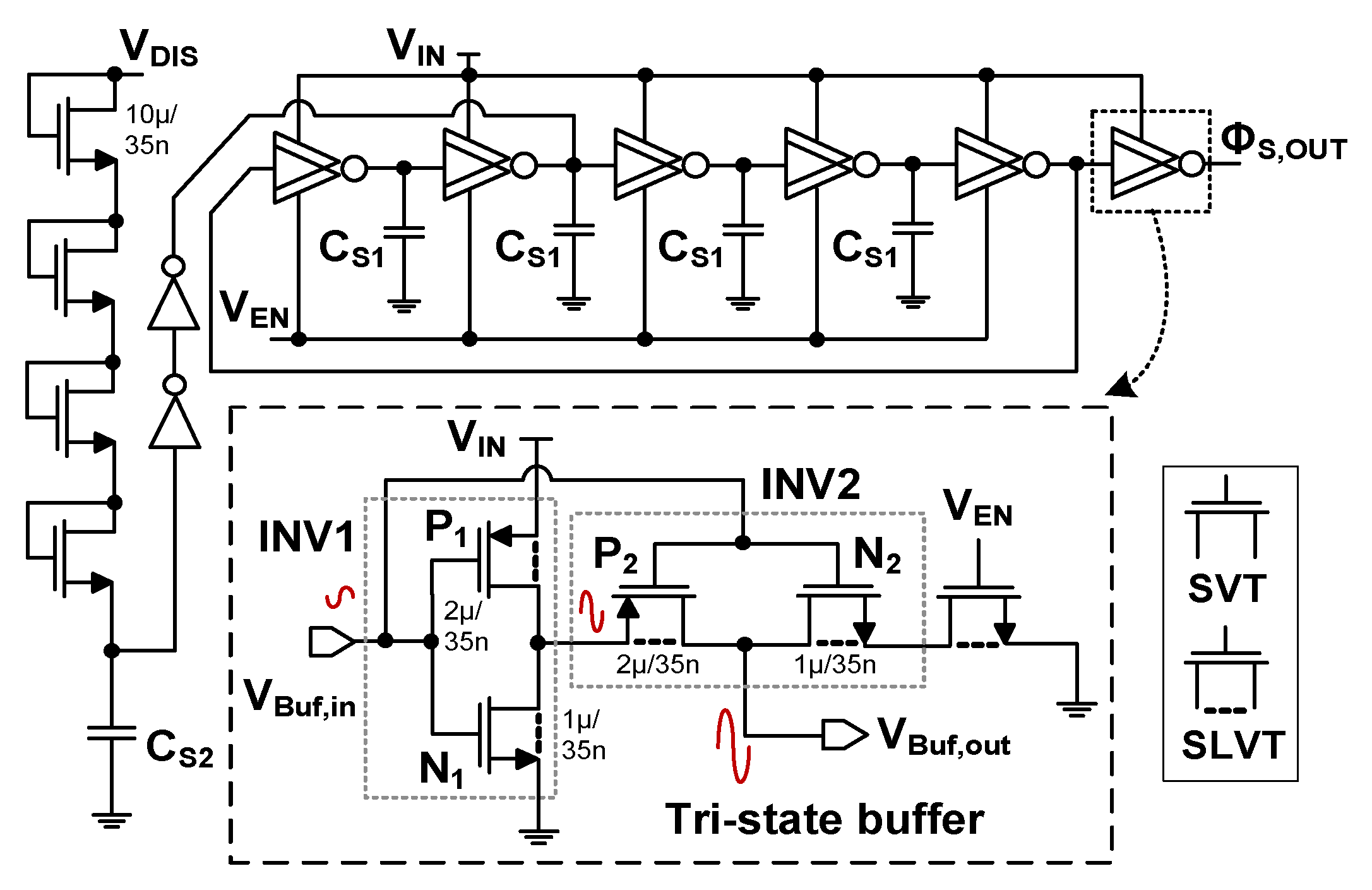


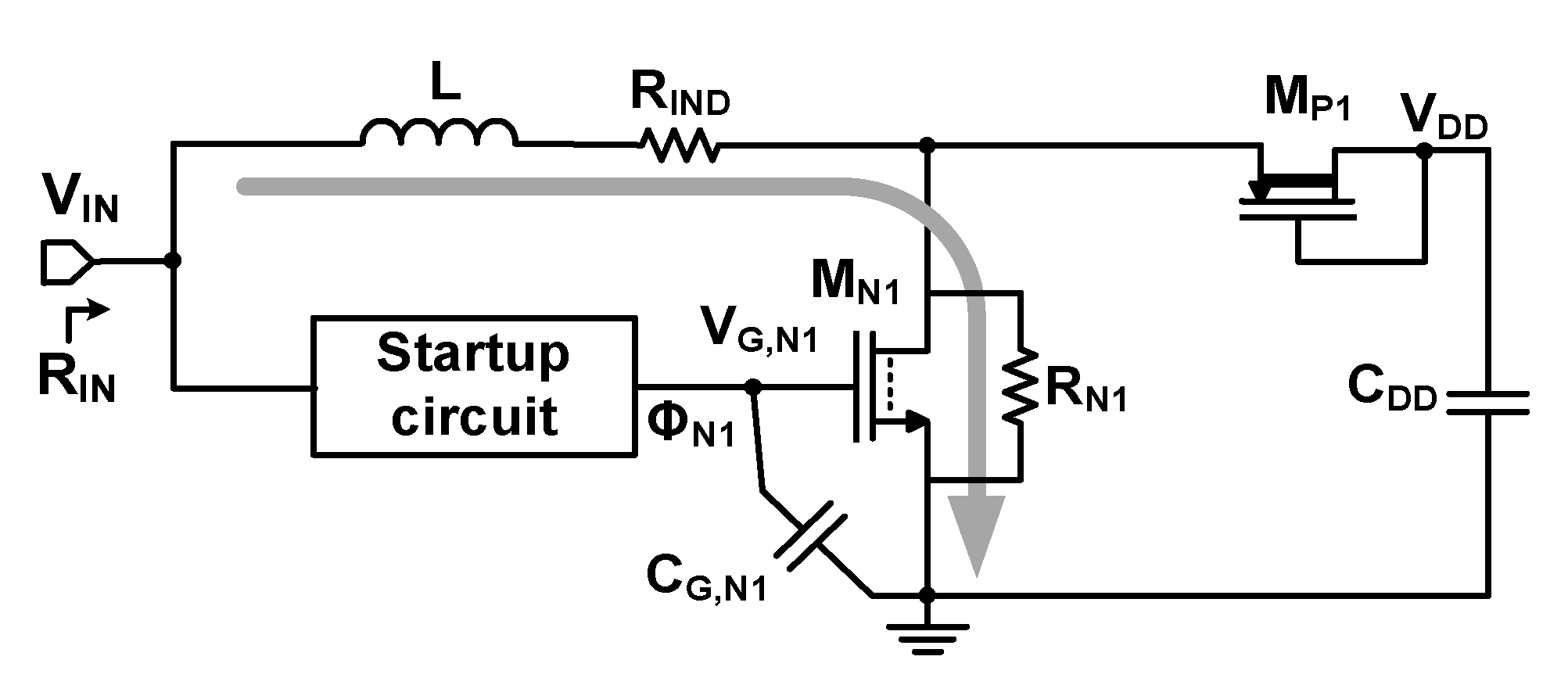
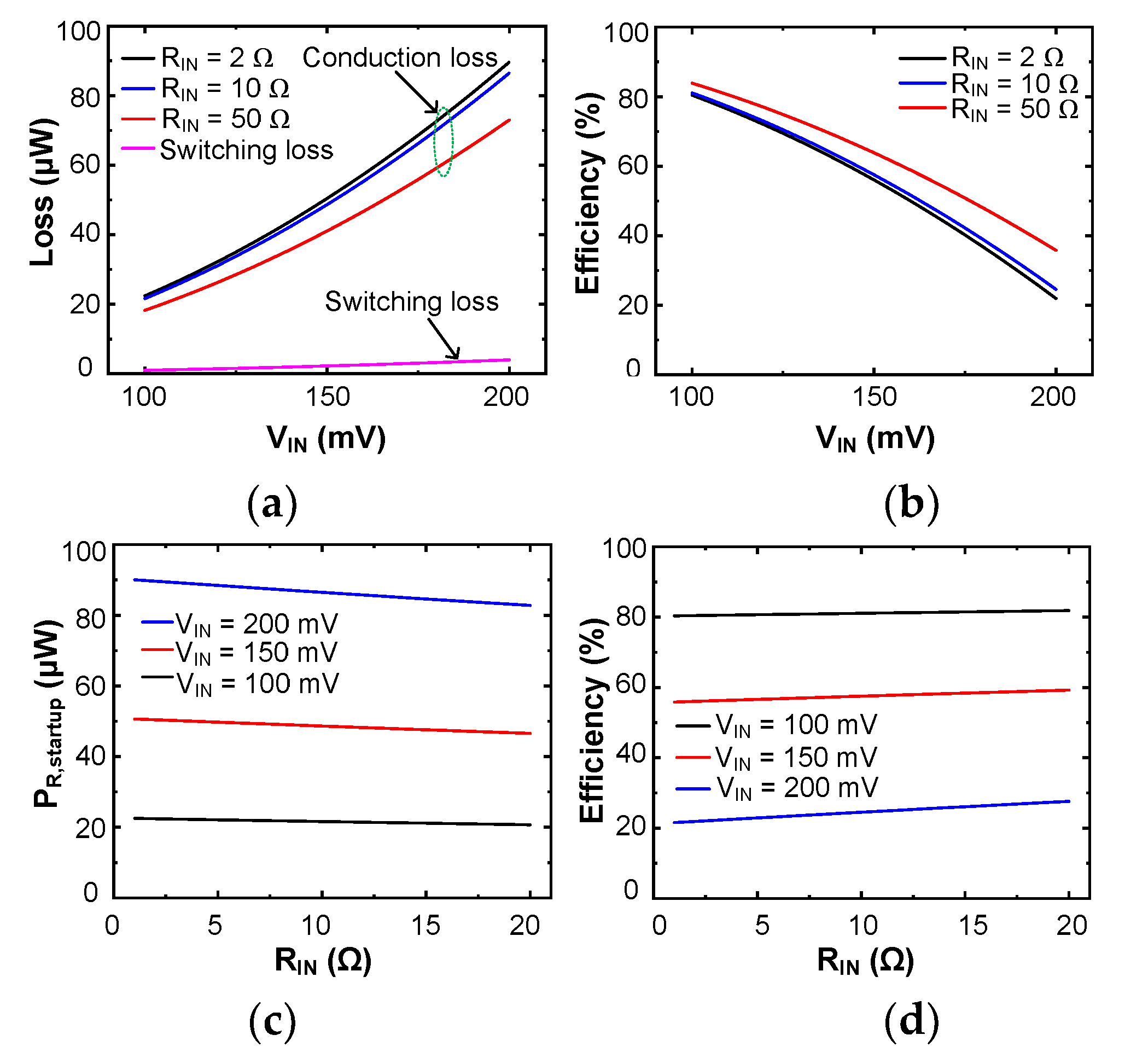


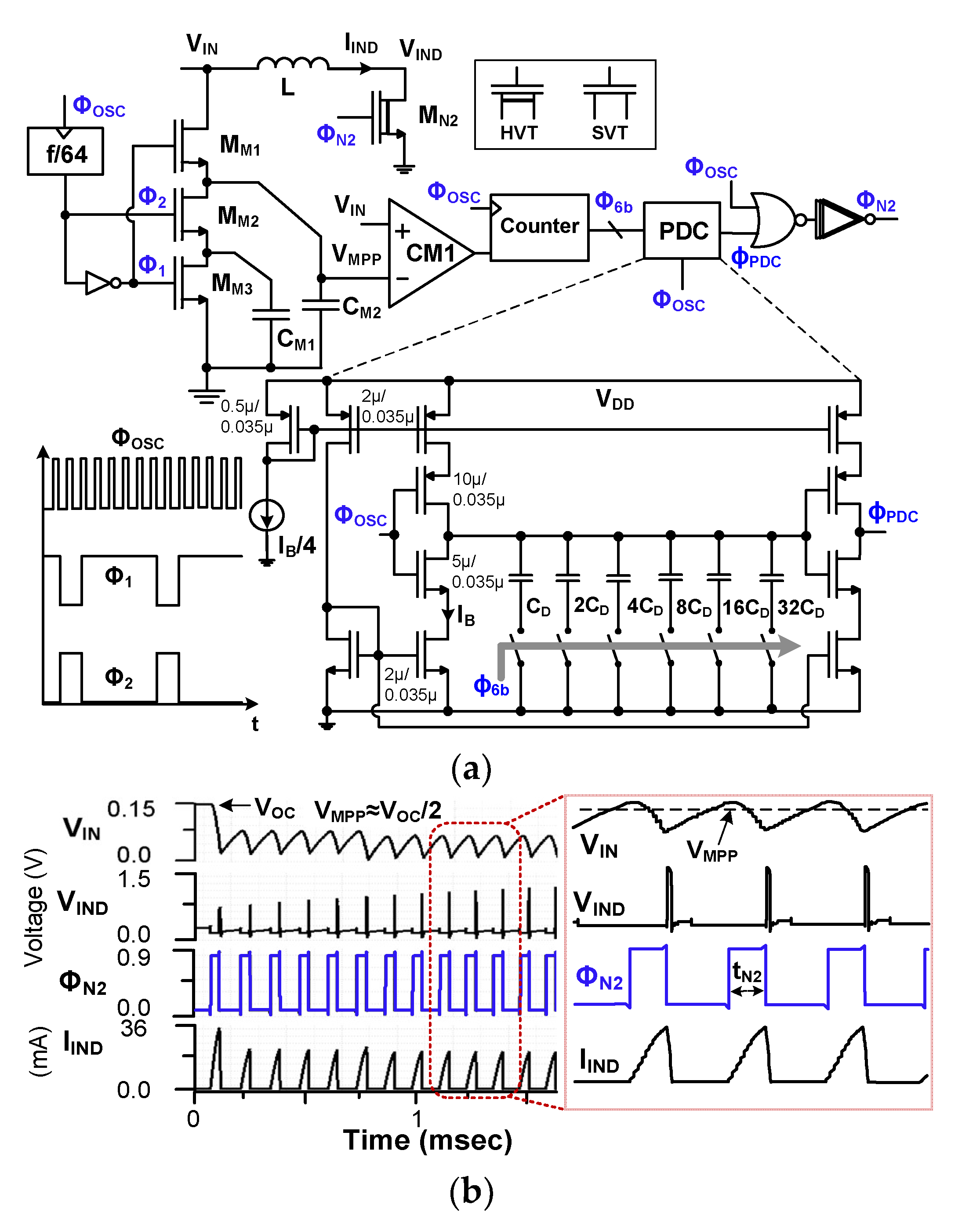



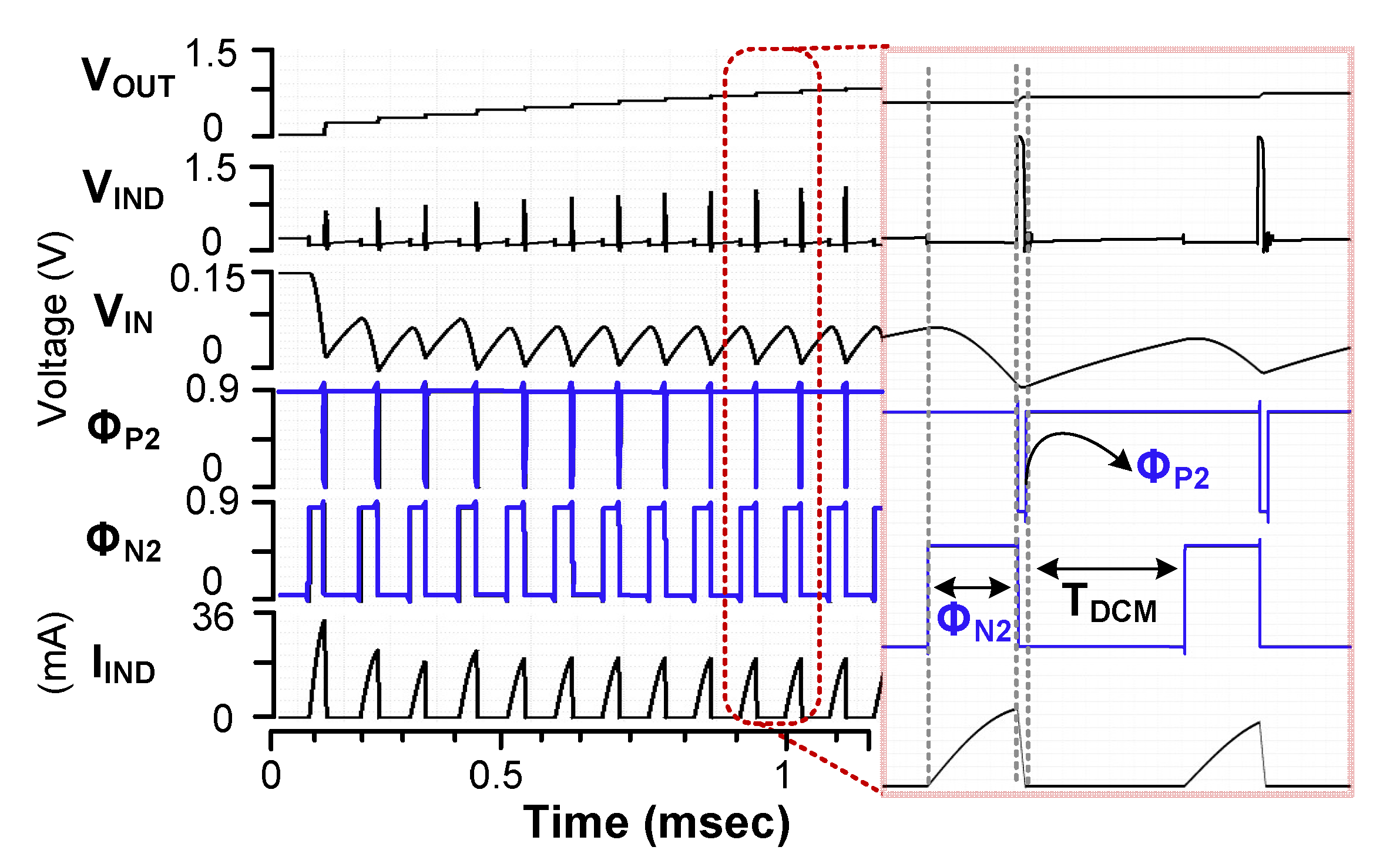


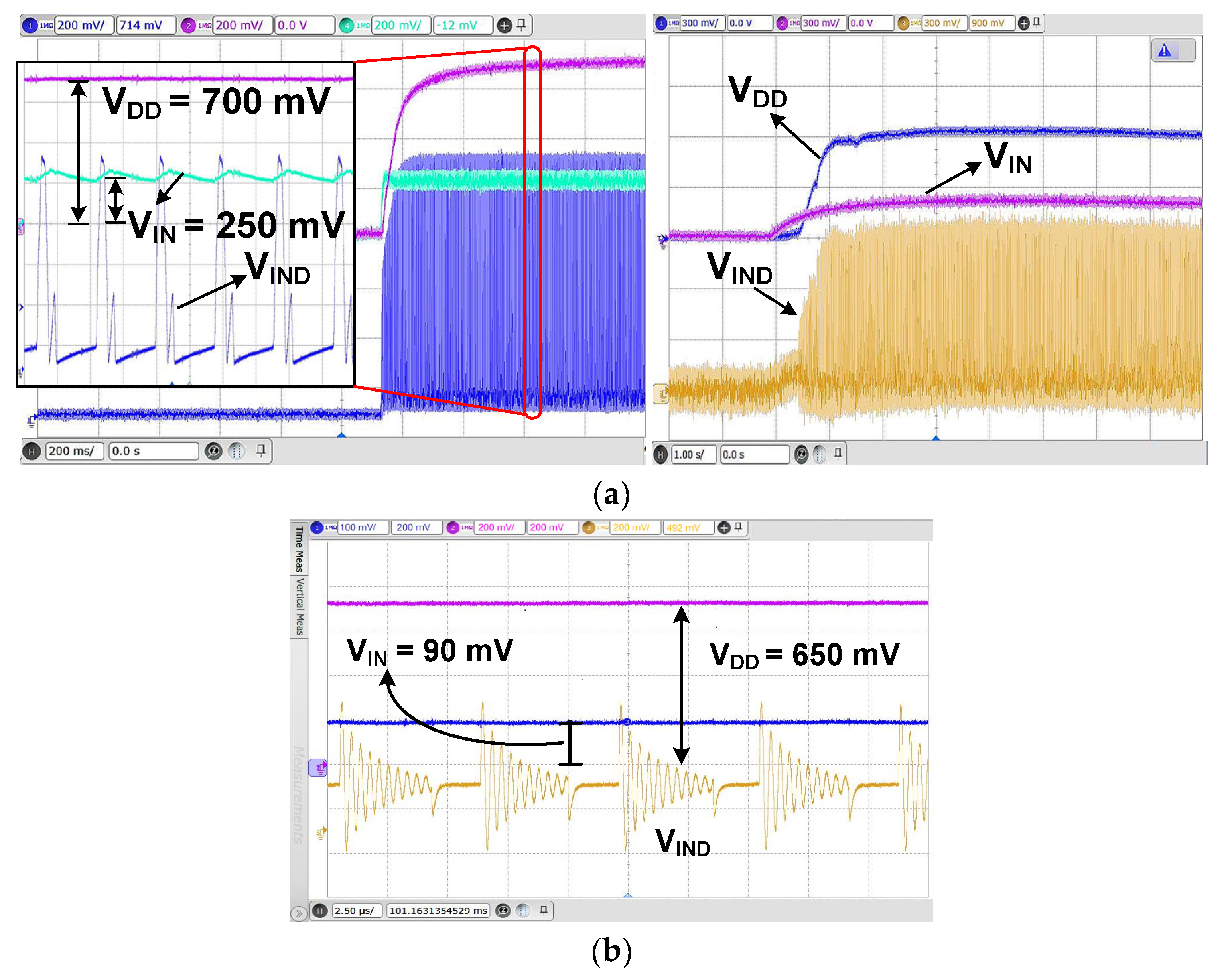
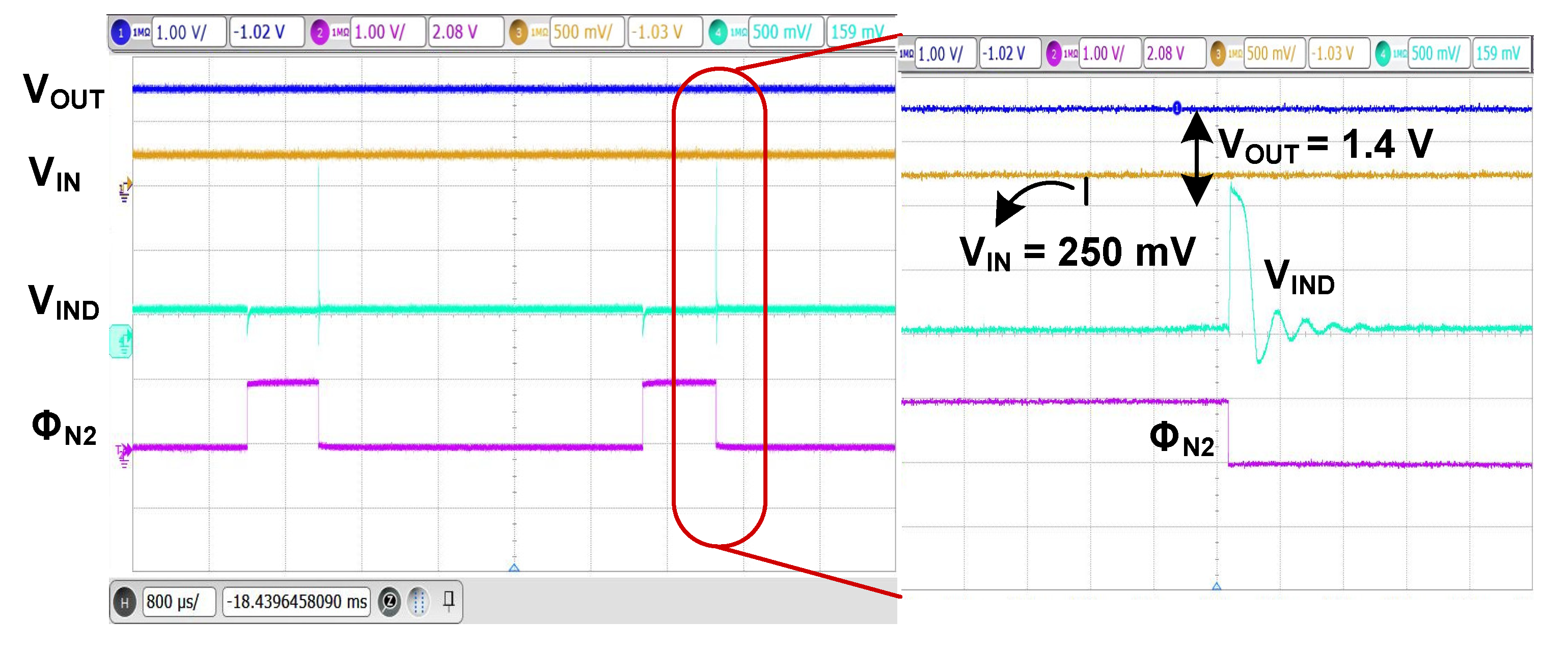

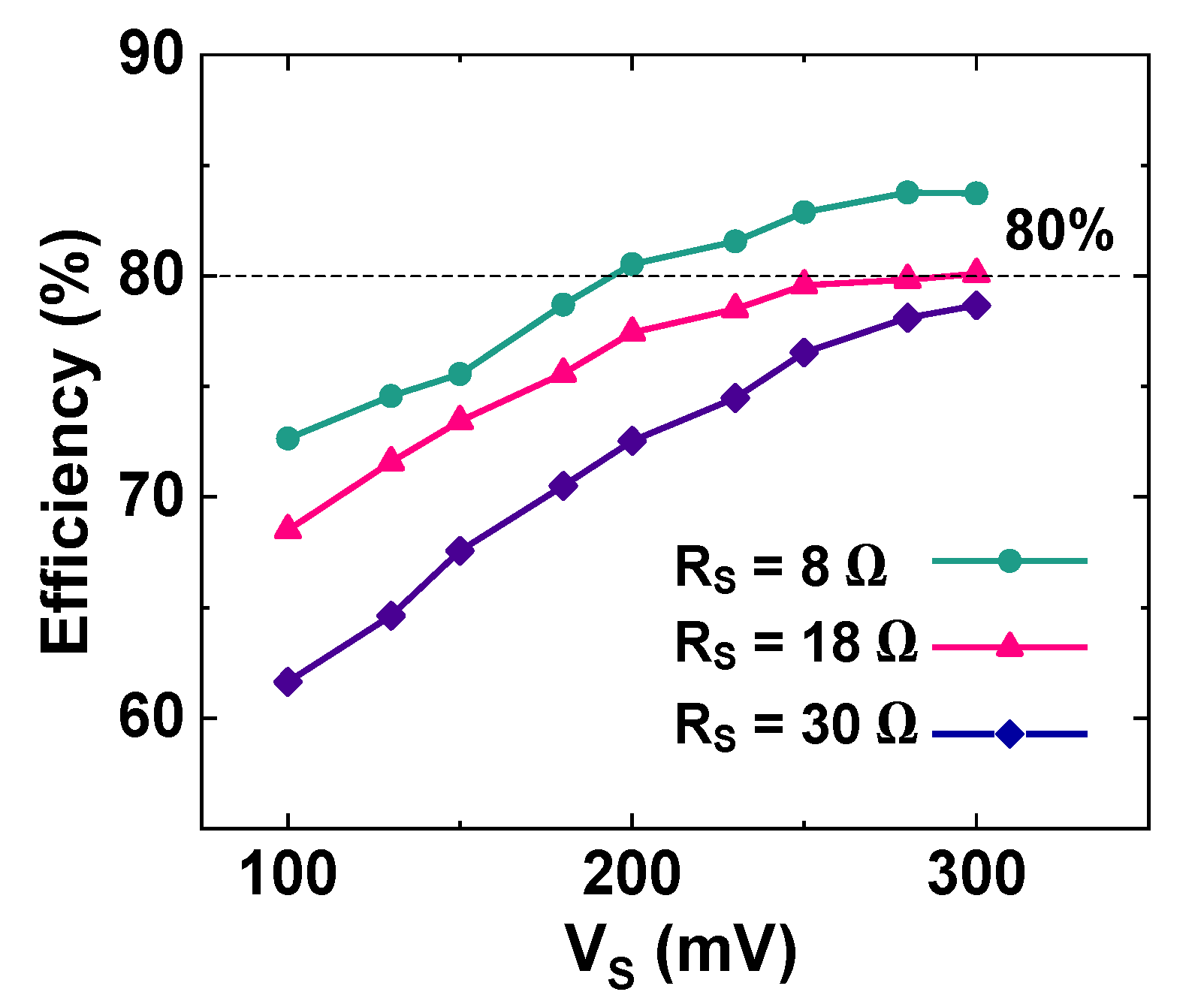
| Power Switch | On-Resistance | Gate Capacitance | Size (W/L) |
|---|---|---|---|
| MN1 | RN1 = 0.40 Ω | CG,N1 = 45.2 pF | 2048 μm/35 nm |
| MN2 | RN2 = 0.18 Ω | CG,N2 = 15.4 pF | 2048 μm/35 nm |
| MP2 | RP2 = 0.45 Ω | CG,P2 = 9.1 pF | 4096 μm/35 nm |
| [25] | [26] | [27] | [28] | [29] | [30] | [31] | [32] | This Work | |
|---|---|---|---|---|---|---|---|---|---|
| Process | 65 nm | 180 nm | 180 nm | 180 nm | 180 nm | 180 nm | 28 nm | 28 nm | 28 nm |
| Energy source | TEG | TEG, PV | TEG | TEG, PZ | TEG | PV | TEG, PV, BFC, Battery | TEG, RF | TEG |
| Type | Boost | Buck-Boost | Boost | Boost | Boost | Boost | Buck-Boost | Boost | Boost |
| Startup technique | OSC + CP | Ring OSC + CP | CP | − | Ring OSC + CP | CP | Battery | LC OSC | Tri-state buffer, Ring OSC |
| Minimum startup voltage | 210 mV | 370 mV | 500 mV | 100 mV | 129 mV | 80 mV | − | 110 mV | 90 mV |
| ZCS technique | Dynamic comp. | gate comparators | One shot pulse gen. | Latched comp. | D- F/F | Comparator, D-F/F | Digital calibration | − | * MOVT |
| MPPT technique | FOCV | FOCV | † AIR | †† DPR | OCV | ††† SRFG | FOCV | †††† ASF | FOCV |
| ηCONV | 74.5% @ POUT = 229 μW | − | − | 75.0% @ POUT = 450 μW | − | 89.0% @ POUT = 0.12 mW | 89.0% @ POUT = 20 mW | 25.0% @ POUT = 0.52 mW | 85.9% @ POUT = 1.07 mW |
| ηEE | 71.5% @ VIN = 240 mV | 82.1% @ VIN = 600 mV | 82.0% @ VIN = 600 mV | − | 84.0% @ VIN = 260 mV | 86.0% @ VIN = 260 mV | − | 10.0% @ N/A | 83.7% @ VIN = 280 mV |
| VOUT | 0.86–1.4 V | 1.2 V | 1–1.2 V | 3–4 V | 0.8 V | 1.2 V | 0.4–1.4 V | − | 1.4 V |
| Area (mm2) | 4.57 | 1.23 | 1.1 | 1.5 | 1.62 | 1.5 | 0.5 | 0.46 | 0.03 |
Disclaimer/Publisher’s Note: The statements, opinions and data contained in all publications are solely those of the individual author(s) and contributor(s) and not of MDPI and/or the editor(s). MDPI and/or the editor(s) disclaim responsibility for any injury to people or property resulting from any ideas, methods, instructions or products referred to in the content. |
© 2023 by the authors. Licensee MDPI, Basel, Switzerland. This article is an open access article distributed under the terms and conditions of the Creative Commons Attribution (CC BY) license (https://creativecommons.org/licenses/by/4.0/).
Share and Cite
Ali, M.; Chandrarathna, S.C.; Moon, S.-Y.; Jana, M.S.; Shafique, A.; Qraiqea, H.; Lee, J.-W. A Compact and Efficient Boost Converter in a 28 nm CMOS with 90 mV Self-Startup and Maximum Output Voltage Tracking ZCS for Thermoelectric Energy Harvesting. Sensors 2023, 23, 6243. https://doi.org/10.3390/s23136243
Ali M, Chandrarathna SC, Moon S-Y, Jana MS, Shafique A, Qraiqea H, Lee J-W. A Compact and Efficient Boost Converter in a 28 nm CMOS with 90 mV Self-Startup and Maximum Output Voltage Tracking ZCS for Thermoelectric Energy Harvesting. Sensors. 2023; 23(13):6243. https://doi.org/10.3390/s23136243
Chicago/Turabian StyleAli, Muhammad, Seneke Chamith Chandrarathna, Seong-Yeon Moon, Mohammad Sami Jana, Arooba Shafique, Hamdi Qraiqea, and Jong-Wook Lee. 2023. "A Compact and Efficient Boost Converter in a 28 nm CMOS with 90 mV Self-Startup and Maximum Output Voltage Tracking ZCS for Thermoelectric Energy Harvesting" Sensors 23, no. 13: 6243. https://doi.org/10.3390/s23136243
APA StyleAli, M., Chandrarathna, S. C., Moon, S.-Y., Jana, M. S., Shafique, A., Qraiqea, H., & Lee, J.-W. (2023). A Compact and Efficient Boost Converter in a 28 nm CMOS with 90 mV Self-Startup and Maximum Output Voltage Tracking ZCS for Thermoelectric Energy Harvesting. Sensors, 23(13), 6243. https://doi.org/10.3390/s23136243







